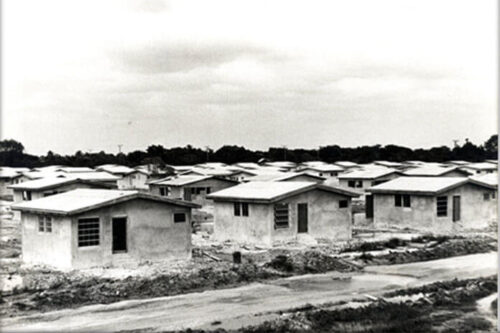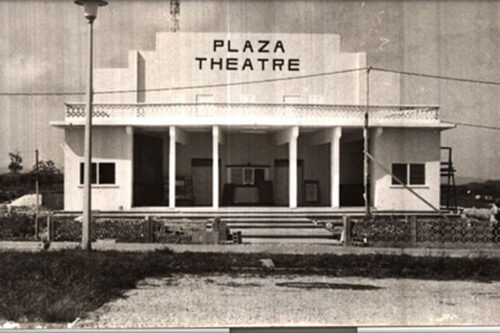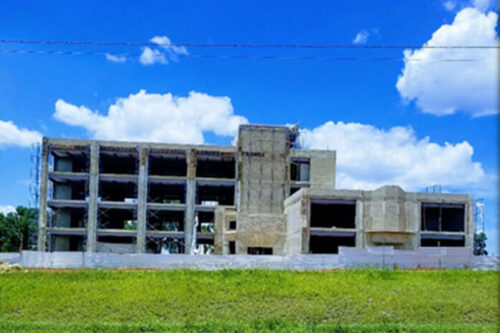July 28, 2020– The City of Belmopan will be celebrating its 50th birthday on August 1, 2020. Belmopan is one of the newest capital cities in the western hemisphere, the seat of the Government of Belize, and home to our National University. Belmopan is a young, vibrant, and growing City in the heart of Belize.
Historical Overview
It was early in the morning on Tuesday, October 31, 1961, that Belize City lost a battle to Mother Nature as the tropical cyclone called Hurricane Hattie devastated the old capital. Over three hundred people lost their lives. The damage to property was in the millions. “Out of this disaster arose the opportunity to build a new capital city. A committee was assigned to choose a site. There were three proposals: (1) a site at about mile 30 to 33 on the Western Highway (2) at the junction of the Western and Hummingbird Highways and (3) somewhere in the Mountain Pine Ridge. Proposal 2, the present site of Belmopan was accepted. With the cooperation of London, plans and financial arrangements were completed in 1967; work began on land donated by the Melhado family.” (Price, G 1995)
The original site consisted of 7,550 acres of pristine, lush jungle. Mahogany, Cedar, Santa Maria, and Nargusta were some of the trees that grew on the estate. In the trees were woodpeckers, hummingbirds, brown jays, parrots, toucans, egrets, and families of howler monkeys. Other wildlife included deer, armadillos, peccaries, and gibnuts. There were several streams in the area and a lagoon that was home to several species of fishes and turtles.
The Reconstruction and Development Corporation (RECONDEV) came to be in late 1962. Their mandate was to oversee the reconstruction of the country after the hurricane, and for the building of the New Capital. Survey works began in 1963; clearing of the first 650 acres of land began in 1965. It was at the beginning of the rainy season (June 1966) that works started on the first 765 houses that were built by the Public Works Department and Pauling and Company. Pauling considered using Mexican and Honduran labor, but their governments refused due to the Guatemalan claim. They ended up settling for Salvadoran and Belizean workers.

The exodus to Belmopan occurred on the first weekend of August 1970, when about 1,500 people moved into their new houses. All civil servants who moved to the New Capital received a housing subsidy and a commuting allowance as an incentive. Government officially moved to Belmopan on August 1, 1970.

Downtown Belmopan was Toucan Avenue in the 1970s. Utility companies like Belize Electricity Board (BEB), and the Water and Sewerage Authority (WASA) had their offices there. Other businesses on Toucan Avenue included British American Insurance Co., Yellow Bird Restaurant, Elmas Snack Shop, Royal Bank, Espats Store, the Library, and Lopez Drug Store. Those of us who grew up in Belmopan may recall the Mennonites selling chicken, milk, and eggs from a van at the end of Toucan Avenue, a business that continued well into the 1990s.

In the early days, there were very few social amenities available in Belmopan. Many of our pioneers headed to neighboring Roaring Creek for entertainment. Then Santiago Castillo began showing movies at the market. Plaza Theater came later. Hilltop was a club for expatriates only. After its completion, the Civic Center became home for many activities such as bingo, badminton, and dances. The National Agricultural and Trade Show began to bring liveliness to the community. Several sporting activities began taking place with the growing young population in the 1980s. The Belmopan Choral Society ended 1980 with a Christmas show.
The psalmist told us that, “Unless the Lord builds the house, its builders labor in vain. Unless the Lord watches over the city, the watchmen stand guard in vain”. It is a blessing that most of the major religious denominations came to Belmopan in the early days. The Anglicans began holding services from 1968. They inaugurated an Ecumenical Center in 1971. The Catholics started holding services in 1970. The Our Lady of Guadalupe Co-Cathedral opened its doors on December 24, 1985. Other churches that came in the 1970s included the Methodist, Nazarene, Baptist and Adventist churches, and Jehovah’s Witnesses.
There were three schools constructed for Belmopan in the beginning — Belmopan Infant School, which was envisioned to house 400 children, Junior School for 600, and the Belmopan Comprehensive School for 750 children. In 1976 the 4-H Center was established at the National Agriculture and Trade Show Grounds to cater to the training of youths in agriculture education.
Civil Wars displaced many Central American citizens in the 1980s, and many refugees came fleeing to Belize. Belmopan became a sanctuary for many of them. They settled in the areas of Salvapan, Las Flores, and San Martin. Some of the men provided cheap and fresh agricultural produce, while others worked in construction projects throughout the growing municipality. The women were either housewives or employed as domestic workers in the homes of many public servants. The United Nations High Commission for Refugees (UNHCR) was instrumental in getting these refugees settled in the safe confines of Belmopan. UNHCR supported government socio-economic integration of the refugee population by investing millions of dollars in funding towards education, infrastructure, and healthcare.
Belmopan – 2020
“Today Belmopan is a vibrant and growing city which houses the seat of Government, the Parliament and many of the embassies of the diplomatic corps. We have grown from a town populated by public officers to a place where many young Belizeans have come to raise their families and where many older Belizeans have come to live out their golden years in peaceful, environmentally safe surrounds. It has also grown to become an ethnically diverse but integrated society, very much like the rest of Belize.” (Esquivel, M 1995)
Belmopan is a hub for commercial activities and inland transportation. Toucan Avenue is now mostly residential; the only business that remains there is an office for Belize Electricity Limited. Many Belizeans travel to Belmopan for work. Others come for educational purposes, land matters, immigration matters, to visit the Western Regional Hospital, to apply for US visas, to deal with different government ministries, or to shop for groceries, clothing, and construction supplies. The Belmopan Bus Terminal is always busy with commuters traveling to the north, south, east, and west. Farmers and shoppers converge for our traditionally vibrant Market Days every Tuesday and Friday.
Belmopan has a wide variety of social amenities. There are several coffee shops, restaurants, pubs, and nightclubs. One can also mingle with good folks while grabbing a meal from the many vendors selling delicious street food. The city is home to several artists, artisans, disc jockeys, athletes, musicians, and bands. It boasts two FIFA standard football stadiums. Folks from different parts of the country can now travel to Belmopan for an encounter of fun, food, and entertainment.
Belmopan is now a center for education in the Western Region of the country as many students travel into the City to attend primary, secondary and tertiary institutions. The City is home to the University of Belize – Central Campus. Galen University also has a campus here. Besides, there are five preschools, nine primary schools, and five secondary schools.
Since 2010 the scourge of gang warfare affecting the northern triangle of Central America (Guatemala, Honduras, and El Salvador) has resulted in the forced displacement of thousands of citizens from these countries. Many caravans have migrated north to the United States via Mexico. Some of these asylum seekers inevitably ended up in Belize. The UNHCR reopened its offices in 2016 to support government’s effort to integrate these refugees into the Belizean society. Belmopan is the only place in the country that offers them the opportunity to regularize their status.
The COVID-19 pandemic has hurt the city. The local economy ground almost to a complete halt in April as the entire country went on lockdown to contain and prevent the spread of the virus. Many of our citizens are civil servants and are not directly affected. But, there is a growing number who are in sectors that have been affected by the pandemic. At the end of May, the City Council informed its employees that they would only be receiving eighty percent of their salaries. 2020 has been a challenging year for our city and the entire world at large.
Challenges beyond 2020
Today it is estimated that the population of the city is approximately twenty-five thousand residents. Albeit, behind schedule, Belmopan is still the fastest-growing municipality in Belize. This increase in population has resulted in demands for more services such as sanitation, land distribution, infrastructure, housing, jobs, education, healthcare, and public safety.
Belmopan needs to take up its rightful role as the Capital of Belize. Many believe that the City needs a real and active downtown that is alive in the daytime and at night. There is a need for a new City Hall, a new hospital, and at least one five-star hotel. Belmopan started with a Master Plan. Most current developments lack proper planning, hence the infrastructure in these areas is of lower quality when compared to the original Belmopan that boasts asphalt streets and concrete drains. While there is a new Municipal Development Plan, its recommendations need implementation. We need to get back to the days of building a planned city with proper standards.
The city should not abandon the dream of an Industrial Zone. Efforts need to be doubled to realize this goal of a city with manufacturing plants that create jobs, and spur the local economy, therefore stimulating the growth of the city and the country.
Some believe that COVID-19 has exacerbated problems with the city’s municipal finances. In 2016 the City Council had floated a bond of 6.5 million dollars. These funds were secured by the Council pledging its government subvention for the life of the debt (2031). It also planned to improve its collection rate of property fees from 72% to as much as 88%. Even before COVID-19, the Council was facing severe cash flow challenges. With COVID-19 and an early back-to-school initiative, citizens will be even more strapped for cash; consequently it will be a challenge to maintain a collection rate of 72%, let alone one of 88%. The Council needs to identify new and innovative revenue streams to meet its growing expenses. The City Council needs to be financially viable so that it can play a leading role in the development of the municipality.
The story of Belmopan could not be complete without also recounting the story of the University of Belize. Even though the University came some thirty years later, it was always a part of the master plan of the Father of the Nation when he laid the foundation of the City. Today, we see that COVID-19 is forcing the University to undergo drastic changes. The government has slashed its subvention by about 25%, and student enrollment is down. The University’s administration recently announced significant salary cuts as part of its cost-saving measures. In response, the UBFSU (University of Belize Faculty and Staff Union) took to the streets to demand respect and an opportunity to make meaningful contributions as to the way forward. A founding member of the faculty summed it up well by asking, “Where do we go from here, UB?” Hopefully, in times to come we will be able to look back and see this phase as one in which UB changed for the better.
The City of Belmopan has come a long way in its first fifty years. As we celebrate this joyous occasion, we owe a debt of gratitude to the pioneers of our city. Today we stand on their shoulders. We walk on streets we did not build. As to where we will be in the next twenty-five or fifty years, no one knows for sure. But we do know that Belmopan will continue to grow and prosper. The torch has passed to a new generation of Belmopanese who have faith in our Heavenly Father, our Nation, and our beloved Garden City. Happy twentieth birthday, UB! Happy fiftieth birthday, our beloved Belmopan!


